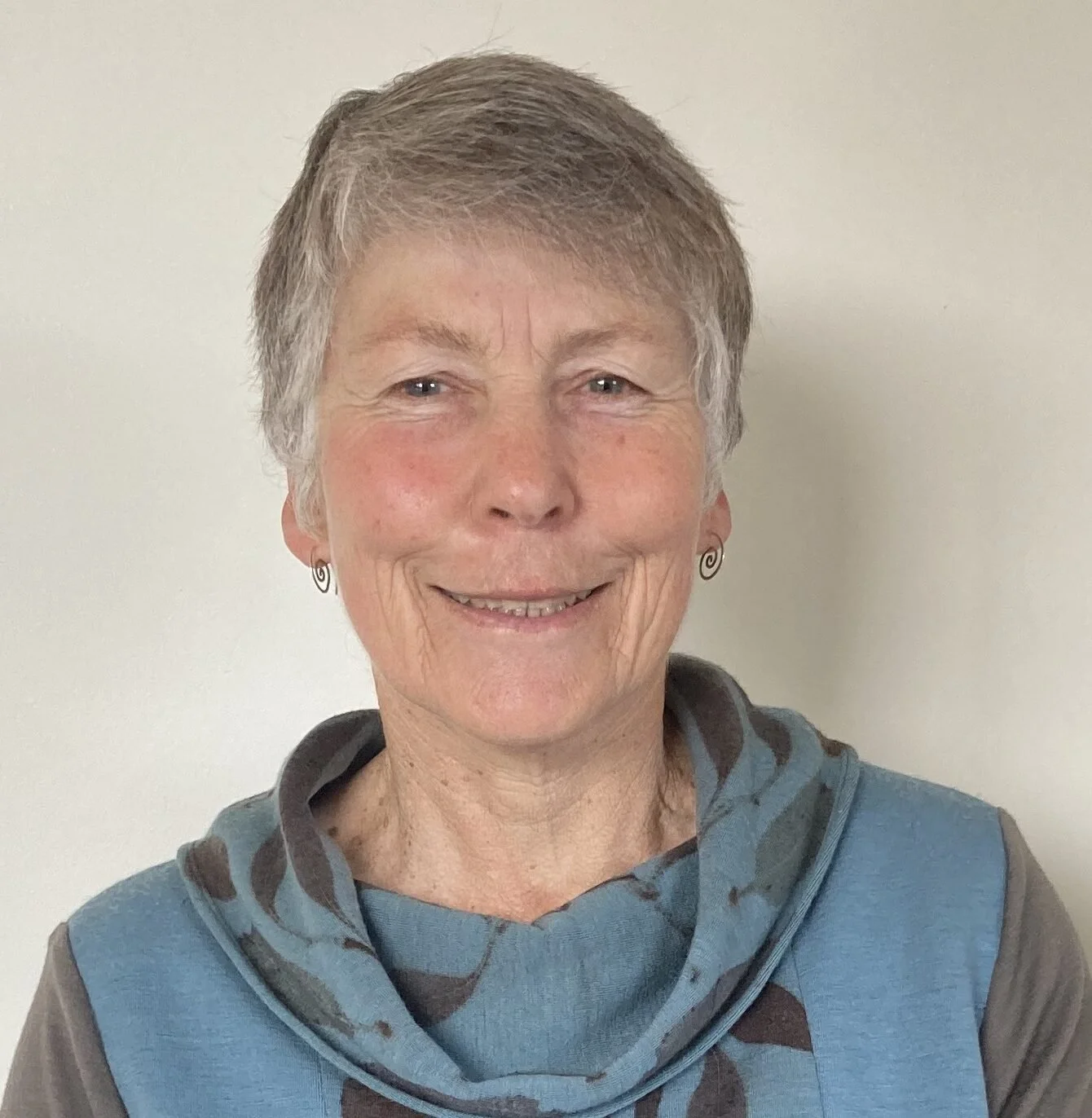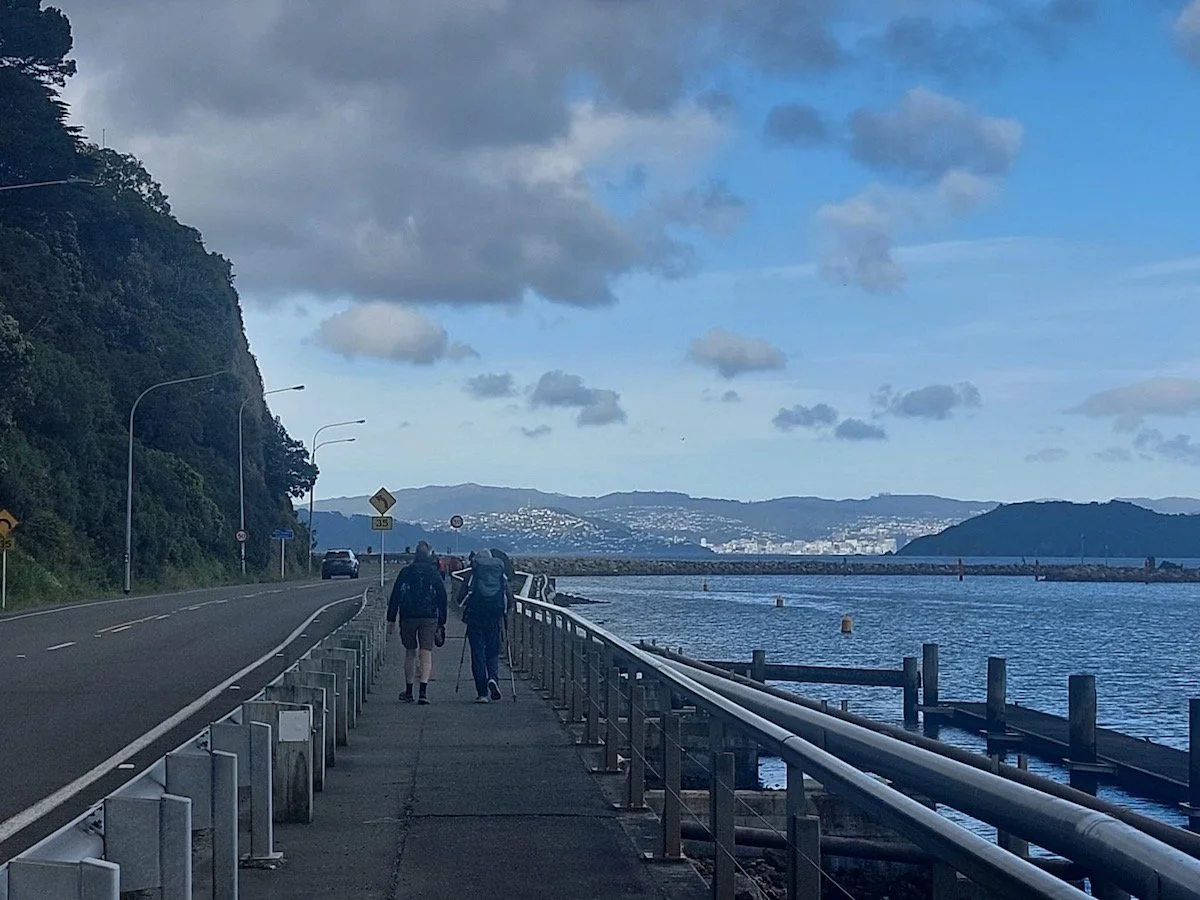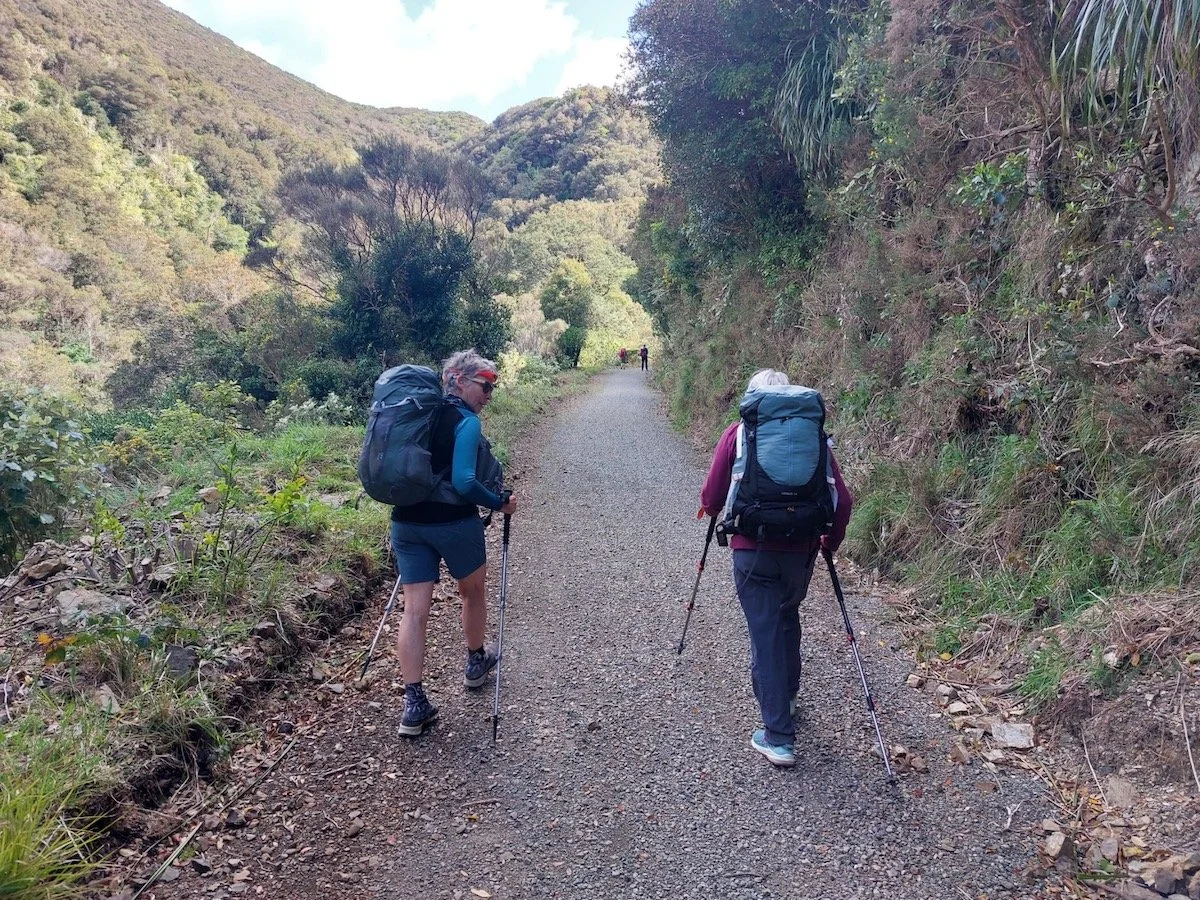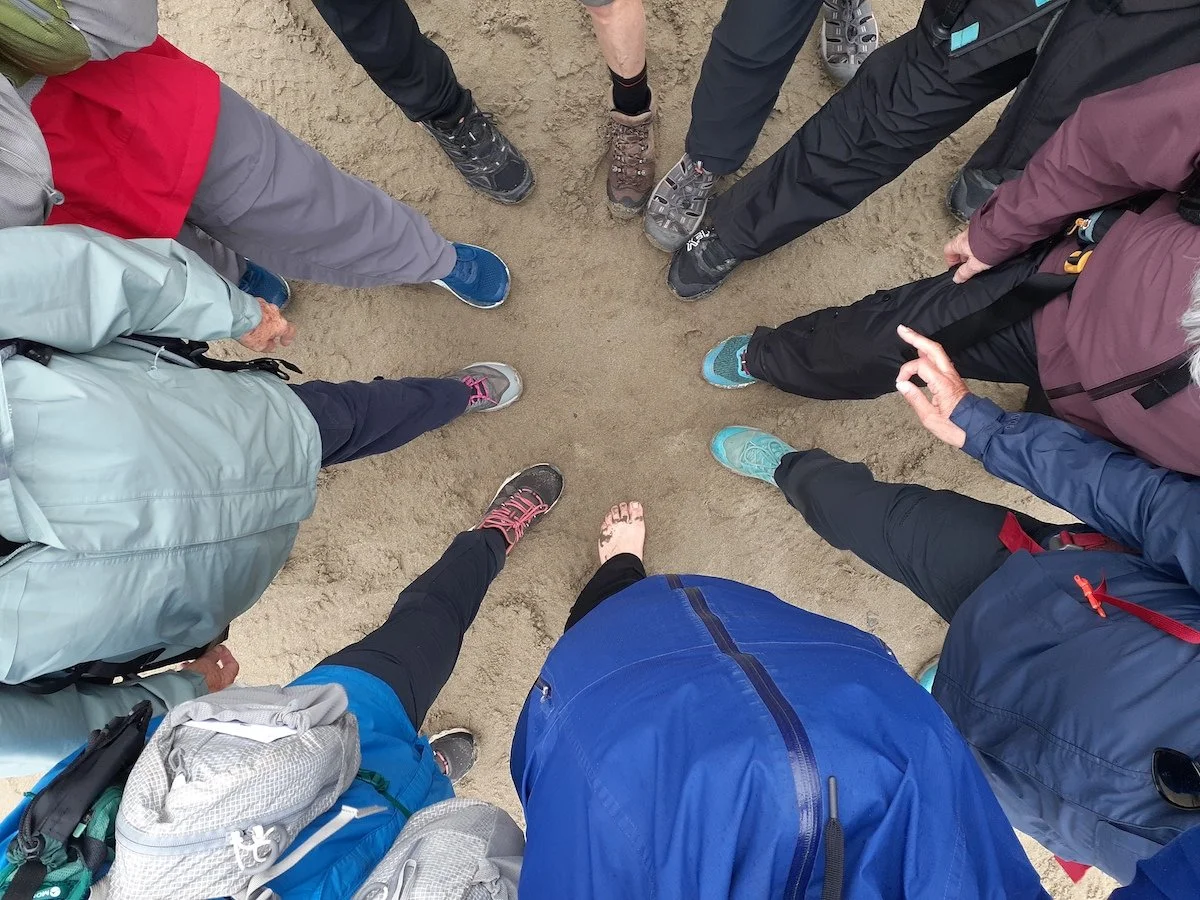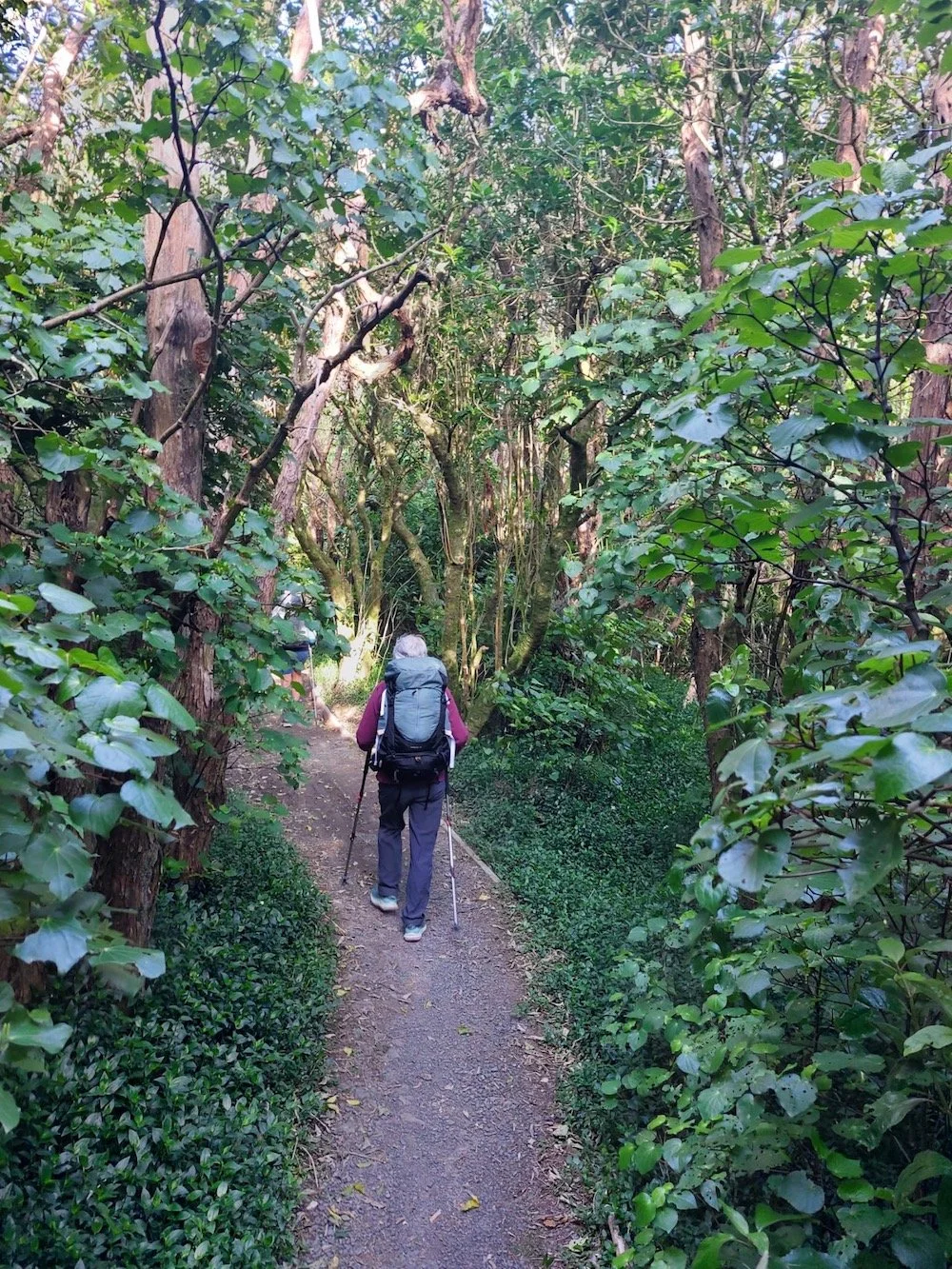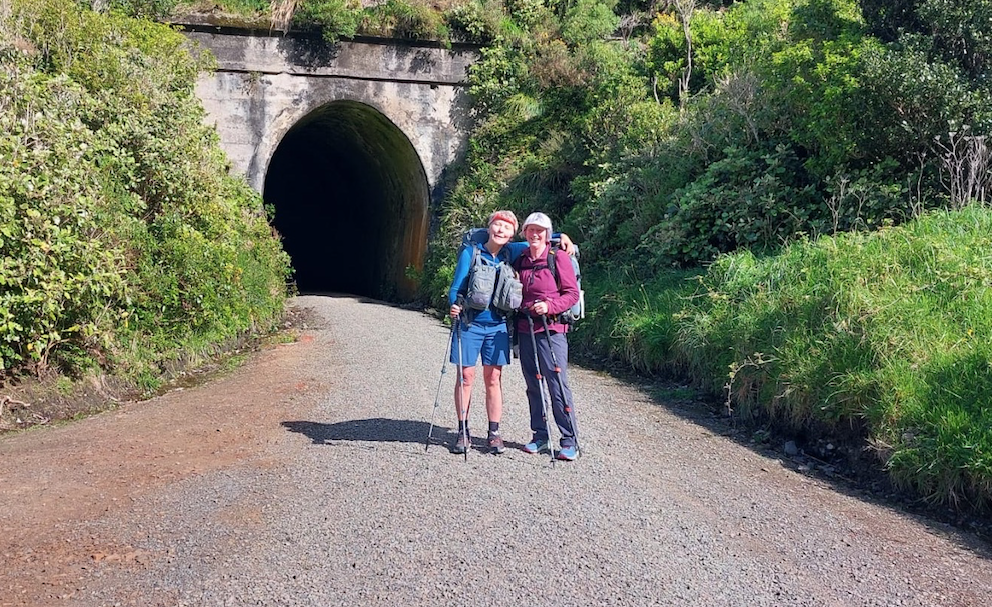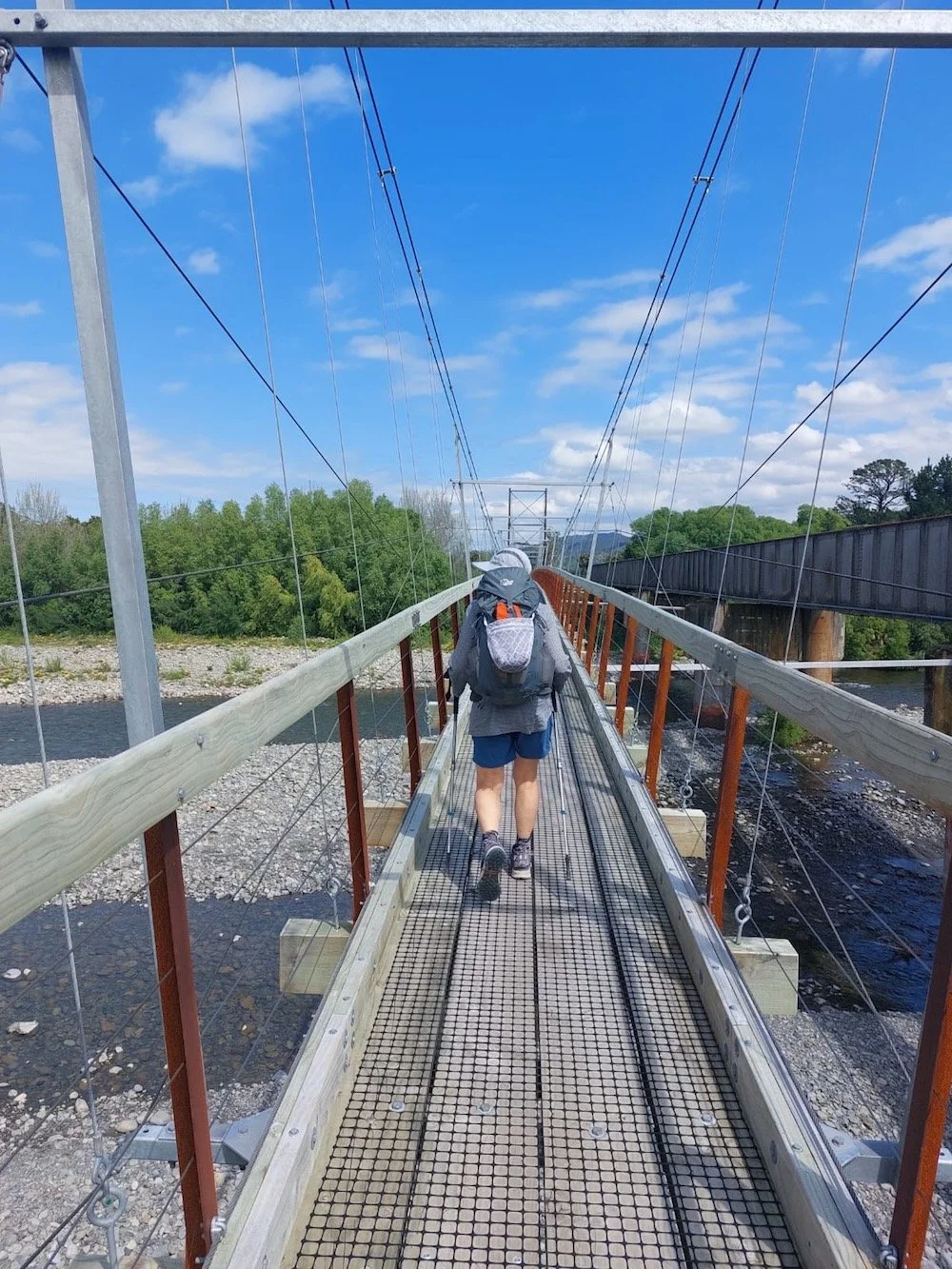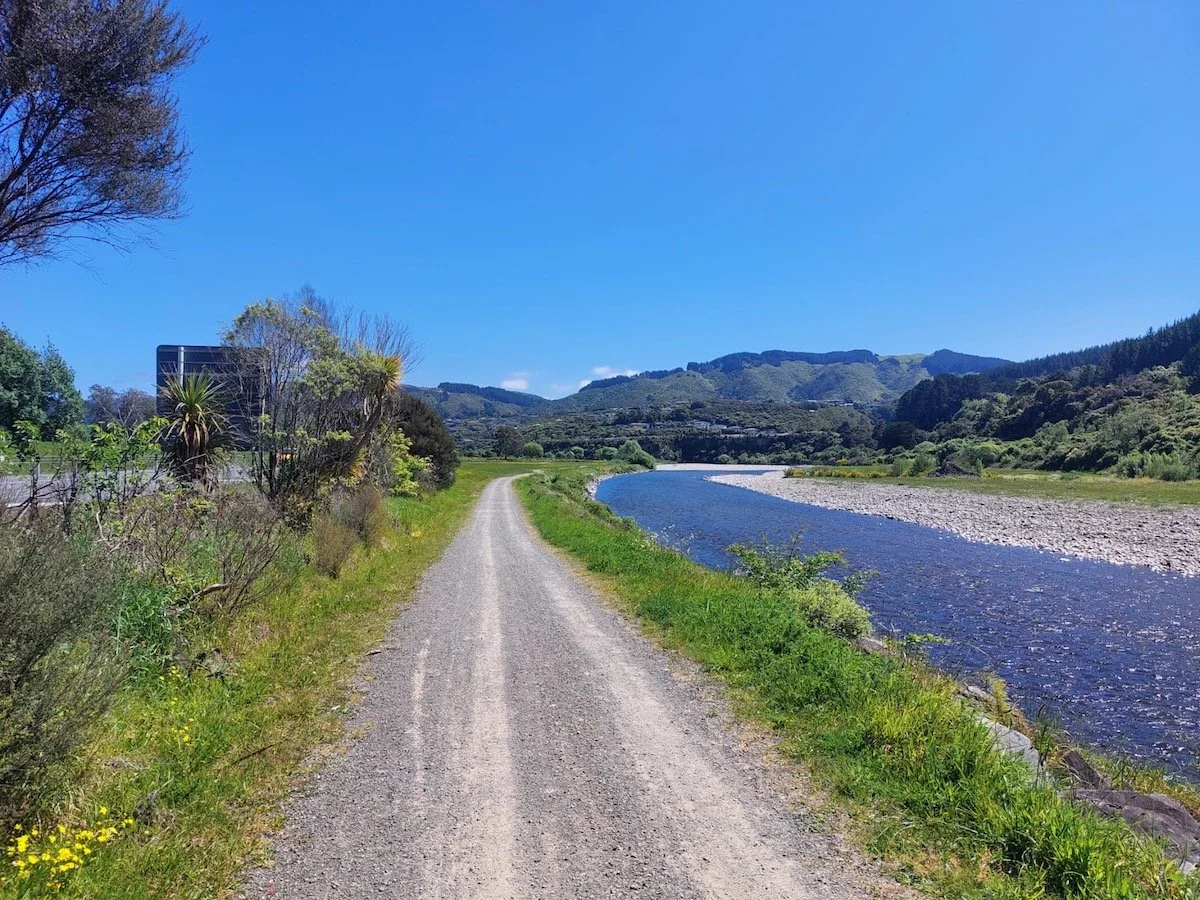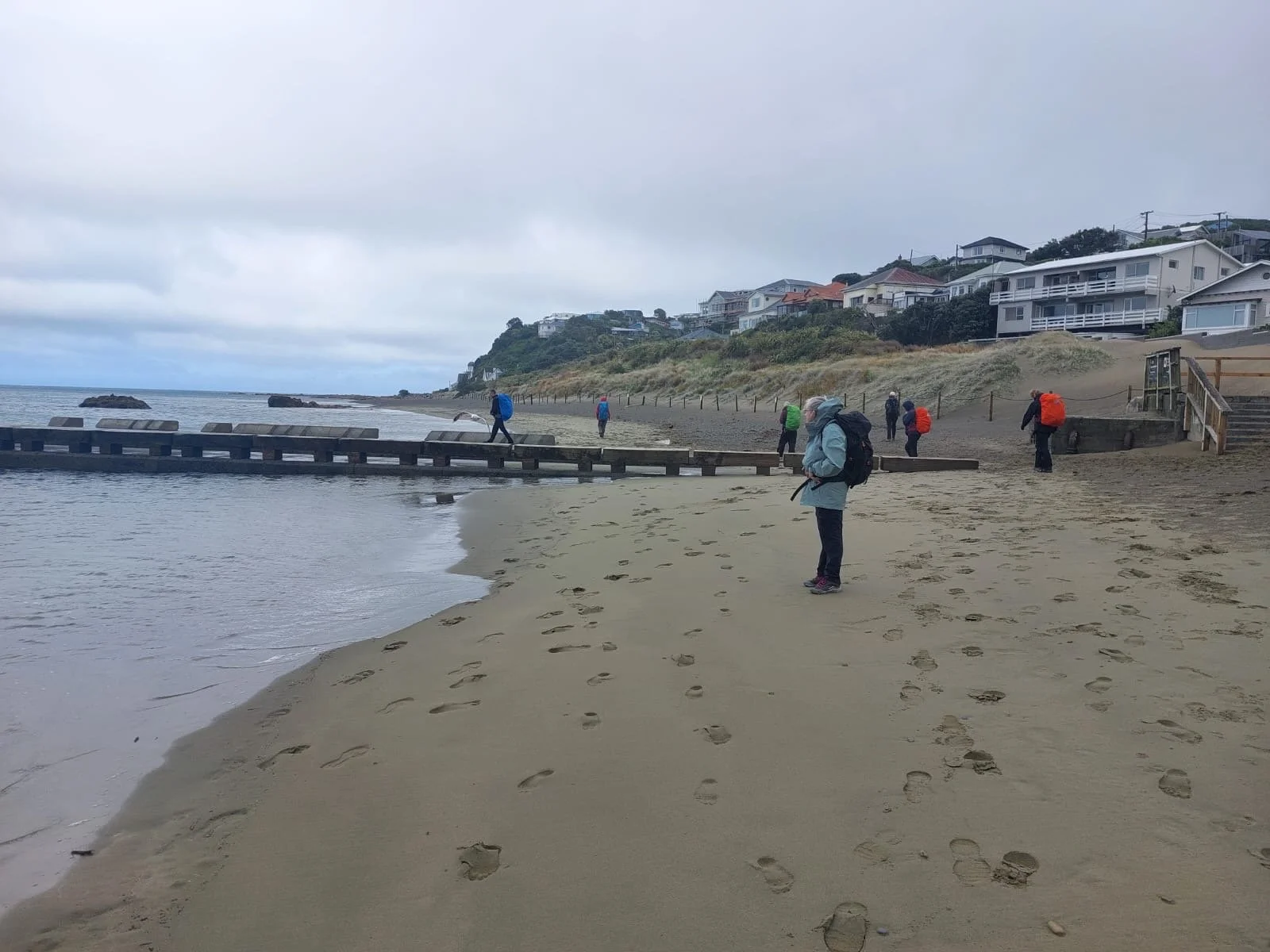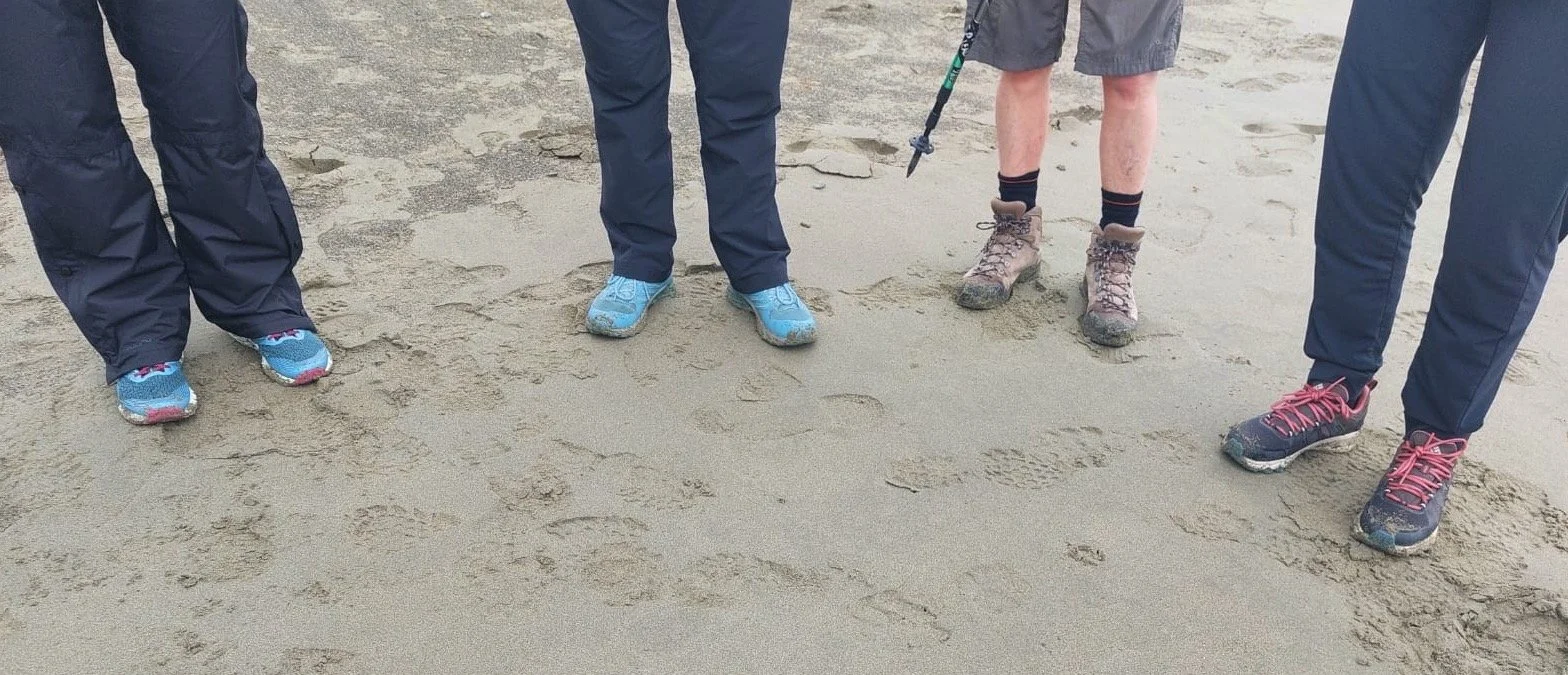Pilgrimage Invitations | An interview with Helen Gray & Kathryn Fernando on ‘traveling lightly’
An SGM Interview with
Helen Gray & Kathryn Fernando
Pilgrimage Invitations
Kathryn Fernando and Helen Gray are spiritual directors and pilgrims who are facilitating contemplative pilgrimage opportunities in Wellington. In this blogpost, Kathryn Overall-Cass has a conversation with them about the gifts and fruit of pilgrimage as a spiritual practice and their upcoming pilgrimage retreat from Wairarapa to Island Bay in October 2025.
Could you each share something about your overseas pilgrimage experiences?
Kathryn: I’ve done two overseas pilgrim walks – in France: Le Puy to St Jean Pied de Port, and then the Camino Frances to Santiago de Compostela (twice).
Each of the walks took five weeks; the first time I was with a group of five, the second was just me, and the third was with my brother.
I came home from each of these long walks with profound insights which have had ongoing impact on my life. Sometimes these were joyous insights, sometimes they were painful. But all were valuable.
Helen: In 2007, I walked the Camino de Santiago from Roncesvalles to Santiago with my husband.
This was fulfilment of a long-held dream. I loved tramping but felt that tramps ended just as I was getting into the rhythm. I became curious about long-distance walking: what would happen within if one were to walk for weeks on end?
On that first camino I was a beginner exploring the pilgrim format of: pack, walk, find shelter and food, unpack, wash, sleep; repeat daily for five weeks.
In 2019, I walked alone for three weeks on the Via de la Plata, a different pilgrim route in Spain. I knew the pilgrim rhythm, so this time my inner journey was central, and walking alone gave me plenty of opportunity to be with God and my deeper self.
What have been the gifts and fruit of engaging with pilgrimage as a spiritual practice?
Kathryn: Getting away from normal life and being on the road for five weeks at a time has each time opened me up to new insights. Being with others, sometimes in quite close quarters, getting tired, having very little to concentrate on each day except walking to the day’s accommodation, being out in nature, meeting new people – all these aspects of a pilgrimage have increased my self-knowledge and opened me up to God.
Helen: Through my pilgrim experiences I have come to believe that our bodies store at a profound level the truths that we learn as we walk. It is not just head learning. For example, when I crest a hill and see a large landscape laid out ahead and know that I will walk my way into that landscape and out the other side, it builds my sense of capability and resourcefulness for the ‘hills’ and ‘large landscapes’ of my life.
These are some other truths that I have walked into my body and soul through making pilgrimages:
You can only be where you are right now.
It is always possible to take the next step, even just a tiny one.
Trust the path - and the process of step after step – and you will get to where you want to go.
What was the catalyst that led you to facilitate pilgrimage retreat experiences in New Zealand?
Kathryn: I had been planning to walk another route in Spain in April 2020, but…covid! When the world shut down to travelling in March 2020, I started to review my attitude to overseas travel. An idea about walking from Kāpiti to Island Bay grew within me. I was living in Kāpiti at the time and wondered if I could organise a supported walk from Waikanae to Island Bay along the Te Araroa route.
My original vision was a walk where people carry their packs each day, stay in new accommodation each night, buying the food required each day. We would walk in a reflective manner and have a group get together each evening to reflect on what’s come up that day.
I asked my friend Bev Phillips (spiritual director and avid pilgrim) if she would be interested in co-leading such a walk. She was keen, and we went on to lead Wellington Caminos 2022, 2023 and 2024. I also supported Helen to lead the Wairarapa to Island Bay Pilgrimage in 2024 and we will be co-leading that pilgrimage route again in October 2025.
Helen: Because of global warming, I no longer feel comfortable travelling overseas to walk pilgrimages. I wanted to find ways to be a pilgrim in New Zealand. I have been doing parts of the Te Araroa trail but I wanted to walk with others who value their spirituality. So, when I saw the first Wellington Camino led by Kathryn Fernando in 2022, I was in!
Seeing how well that model worked here in New Zealand, I became interested in initiating a pilgrimage that involved some elements commonly used in retreats. My idea is to keep this to a minimum, travelling light in our words as well as in practical ways.
What would you like readers to know about your upcoming pilgrimage in Oct 2025: Travelling Light / A Pilgrimage from Wairarapa to Island Bay?
Helen: You can do it! With some time dedicated to training for 2-3 months, most people would be capable of managing this walk. Most of the route is on trails or quiet country roads, with the odd section of urban footpath.
We will walk an average of 16km a day from Greytown to Island Bay, carrying our own gear, buying/cooking meals as we go, and staying in comfortable prearranged accommodation. This year you will have the option of paying more for your own room, or sharing and keeping costs lower. A sleeping bag won’t be required.
Besides walking, talking, eating and sleeping, our days will involve times of silence, meditation and group discussion as we make this pilgrimage. When you walk for hours every day and are open to God, your inner journey will be rich.
View our pilgrimage retreat listing on the SGM Retreat Calendar for more details.
Can you say more about the theme of ‘travelling light’? What invitations does this hold for participants?
Kathryn: On a pilgrimage, one is forced to travel light, and the wise pilgrim takes as little as possible on the journey. One starts to think that actually very little in the way of possessions is needed.
The pilgrim lives the ‘travelling light’ metaphor, and in doing so it becomes hard to avoid reflecting on questions such as: “What do I carry in my inner life/relational life/attitudinal life that is making my life more burdened”; “What impact do my possessions have on me?” etc.
Helen: John O’Donohue said, “Most of us are moving through such an undergrowth of excess that we cannot sense the shape of ourselves anymore.” I hope that pilgrims will finder a greater sense of their ‘shape’ by travelling light in three aspects:
Material things: We live for a week with what we can comfortably carry for about 100km, plus what we can find along the way. Eg. Most pilgrims have one set of clothes for walking and one for evenings. We might experience this as liberating or frustrating, but we get used to just being who and how we are with each other. Some pilgrims decide to live more simply back home too.
Words. We can’t read while we walk, so we make do with a few ideas simply put. Like digesting food, the ideas are broken down into their essence and absorbed at a deeper level as one walks with them.
Expectations. We become more present to the body, and aware of physical and mental fatigue. A pilgrim learns that trying to keep up with someone who walks a faster pace can produce a strained calf muscle by the end of the day, so keeping to their own pace becomes important. One develops a greater sense of self and what one needs to be content. There’s a phrase often quoted by long-distance walkers: ‘Walk your own walk’.
What is your relationship to the landscape and communities you walk through from Wairarapa to Island Bay? How important is ‘place’ in pilgrimage?
Helen: All of nature is infused by God, so when we become present to place as we walk, we are opening to God. I enjoy being aware of how elements in the landscape – mountains, rivers, coasts – connect with my inner journey.
For instance, after three days of following the Hutt River downstream – and becoming quite fond of it – one sees it empty into Wellington Harbour. That water is no longer a river, it has changed it’s identity and form, a possible metaphor for death that invites reflection on:
“What is it like to journey towards one’s disappearance, one’s absorption into the hugeness of God?”
The ‘Travelling Light’ pilgrimage route is deliberately planned as a movement from small-town hinterland (which makes up a large part of New Zealand) to the ocean.
Along the way we stay in two active Christian Communities (Magnificat and the Home of Compassion) and appreciate their welcome and hospitality.
We have our final contemplative time on the shore. There can be profound significance in this arrival.
What are your hopes for the people who join you on your pilgrimage retreats?
Helen:
That they experience walking as a useful and enjoyable contemplative practice.
That as we make the outer journey, they open themselves to God and the inner journey.
That they keep safe and well, and that relationships within the group are supportive and enjoyable.
Kathryn: I trust in God and I trust in the process – if you come on a week long walk, carrying little, leaving your normal life behind for a week – you will return home renewed or changed in some way.



